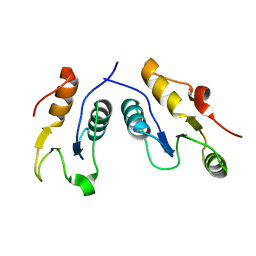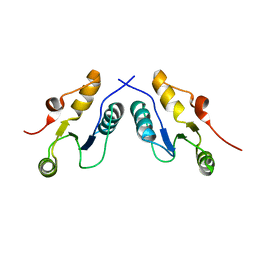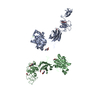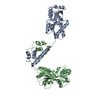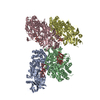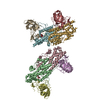[English] 日本語
 Yorodumi
Yorodumi- EMDB-22130: The negative stain EM structure of the human DNA LigIIIalpha-XRCC... -
+ Open data
Open data
- Basic information
Basic information
| Entry | Database: EMDB / ID: EMD-22130 | |||||||||||||||
|---|---|---|---|---|---|---|---|---|---|---|---|---|---|---|---|---|
| Title | The negative stain EM structure of the human DNA LigIIIalpha-XRCC1 complex; conformer 1 | |||||||||||||||
 Map data Map data | Refined 3D map of full-length DNA LigaseIII alpha in complex with full-length XRCC1; conformer 1 | |||||||||||||||
 Sample Sample |
| |||||||||||||||
 Keywords Keywords | DNA repair / protein-protein interactions / DNA BINDING PROTEIN | |||||||||||||||
| Biological species |  Homo sapiens (human) Homo sapiens (human) | |||||||||||||||
| Method | single particle reconstruction / negative staining / Resolution: 31.0 Å | |||||||||||||||
 Authors Authors | Sverzhinsky A / Pascal JM | |||||||||||||||
| Funding support |  United States, 4 items United States, 4 items
| |||||||||||||||
 Citation Citation |  Journal: Nucleic Acids Res. / Year: 2021 Journal: Nucleic Acids Res. / Year: 2021Title: An atypical BRCT-BRCT interaction with the XRCC1 scaffold protein compacts human DNA Ligase III alpha within a flexible DNA repair complex. Authors: Hammel M / Rashid I / Sverzhinsky A / Pourfarjam Y / Tsai MS / Ellenberger T / Pascal JM / Kim IK / Tainer JA / Tomkinson AE | |||||||||||||||
| History |
|
- Structure visualization
Structure visualization
| Movie |
 Movie viewer Movie viewer |
|---|---|
| Structure viewer | EM map:  SurfView SurfView Molmil Molmil Jmol/JSmol Jmol/JSmol |
- Downloads & links
Downloads & links
-EMDB archive
| Map data |  emd_22130.map.gz emd_22130.map.gz | 1.4 MB |  EMDB map data format EMDB map data format | |
|---|---|---|---|---|
| Header (meta data) |  emd-22130-v30.xml emd-22130-v30.xml emd-22130.xml emd-22130.xml | 14.9 KB 14.9 KB | Display Display |  EMDB header EMDB header |
| Images |  emd_22130.png emd_22130.png | 35.1 KB | ||
| Filedesc metadata |  emd-22130.cif.gz emd-22130.cif.gz | 5.8 KB | ||
| Archive directory |  http://ftp.pdbj.org/pub/emdb/structures/EMD-22130 http://ftp.pdbj.org/pub/emdb/structures/EMD-22130 ftp://ftp.pdbj.org/pub/emdb/structures/EMD-22130 ftp://ftp.pdbj.org/pub/emdb/structures/EMD-22130 | HTTPS FTP |
-Validation report
| Summary document |  emd_22130_validation.pdf.gz emd_22130_validation.pdf.gz | 384.5 KB | Display |  EMDB validaton report EMDB validaton report |
|---|---|---|---|---|
| Full document |  emd_22130_full_validation.pdf.gz emd_22130_full_validation.pdf.gz | 384.1 KB | Display | |
| Data in XML |  emd_22130_validation.xml.gz emd_22130_validation.xml.gz | 5 KB | Display | |
| Data in CIF |  emd_22130_validation.cif.gz emd_22130_validation.cif.gz | 5.6 KB | Display | |
| Arichive directory |  https://ftp.pdbj.org/pub/emdb/validation_reports/EMD-22130 https://ftp.pdbj.org/pub/emdb/validation_reports/EMD-22130 ftp://ftp.pdbj.org/pub/emdb/validation_reports/EMD-22130 ftp://ftp.pdbj.org/pub/emdb/validation_reports/EMD-22130 | HTTPS FTP |
-Related structure data
- Links
Links
| EMDB pages |  EMDB (EBI/PDBe) / EMDB (EBI/PDBe) /  EMDataResource EMDataResource |
|---|
- Map
Map
| File |  Download / File: emd_22130.map.gz / Format: CCP4 / Size: 2 MB / Type: IMAGE STORED AS FLOATING POINT NUMBER (4 BYTES) Download / File: emd_22130.map.gz / Format: CCP4 / Size: 2 MB / Type: IMAGE STORED AS FLOATING POINT NUMBER (4 BYTES) | ||||||||||||||||||||||||||||||||||||||||||||||||||||||||||||||||||||
|---|---|---|---|---|---|---|---|---|---|---|---|---|---|---|---|---|---|---|---|---|---|---|---|---|---|---|---|---|---|---|---|---|---|---|---|---|---|---|---|---|---|---|---|---|---|---|---|---|---|---|---|---|---|---|---|---|---|---|---|---|---|---|---|---|---|---|---|---|---|
| Annotation | Refined 3D map of full-length DNA LigaseIII alpha in complex with full-length XRCC1; conformer 1 | ||||||||||||||||||||||||||||||||||||||||||||||||||||||||||||||||||||
| Voxel size | X=Y=Z: 3.3 Å | ||||||||||||||||||||||||||||||||||||||||||||||||||||||||||||||||||||
| Density |
| ||||||||||||||||||||||||||||||||||||||||||||||||||||||||||||||||||||
| Symmetry | Space group: 1 | ||||||||||||||||||||||||||||||||||||||||||||||||||||||||||||||||||||
| Details | EMDB XML:
CCP4 map header:
| ||||||||||||||||||||||||||||||||||||||||||||||||||||||||||||||||||||
-Supplemental data
- Sample components
Sample components
-Entire : Full-length DNA LigIII alpha in complex with full-length XRCC1; c...
| Entire | Name: Full-length DNA LigIII alpha in complex with full-length XRCC1; conformer 1 |
|---|---|
| Components |
|
-Supramolecule #1: Full-length DNA LigIII alpha in complex with full-length XRCC1; c...
| Supramolecule | Name: Full-length DNA LigIII alpha in complex with full-length XRCC1; conformer 1 type: complex / ID: 1 / Parent: 0 / Macromolecule list: all |
|---|---|
| Source (natural) | Organism:  Homo sapiens (human) Homo sapiens (human) |
| Molecular weight | Theoretical: 180 KDa |
-Macromolecule #1: DNA LigIII-alpha-nuclear
| Macromolecule | Name: DNA LigIII-alpha-nuclear / type: protein_or_peptide / ID: 1 / Enantiomer: LEVO / EC number: DNA ligase (ATP) |
|---|---|
| Source (natural) | Organism:  Homo sapiens (human) Homo sapiens (human) |
| Recombinant expression | Organism:  |
| Sequence | String: MAEQRFCVDY AKRGTAGCKK CKEKIVKGVC RIGKVVPNPF SESGGDMKEW YHIKCMFEKL ERARATTKK IEDLTELEGW EELEDNEKEQ ITQHIADLSS KAAGTPKKKA VVQAKLTTTG Q VTSPVKGA SFVTSTNPRK FSGFSAKPNN SGEAPSSPTP KRSLSSSKCD ...String: MAEQRFCVDY AKRGTAGCKK CKEKIVKGVC RIGKVVPNPF SESGGDMKEW YHIKCMFEKL ERARATTKK IEDLTELEGW EELEDNEKEQ ITQHIADLSS KAAGTPKKKA VVQAKLTTTG Q VTSPVKGA SFVTSTNPRK FSGFSAKPNN SGEAPSSPTP KRSLSSSKCD PRHKDCLLRE FR KLCAMVA DNPSYNTKTQ IIQDFLRKGS AGDGFHGDVY LTVKLLLPGV IKTVYNLNDK QIV KLFSRI FNCNPDDMAR DLEQGDVSET IRVFFEQSKS FPPAAKSLLT IQEVDEFLLR LSKL TKEDE QQQALQDIAS RCTANDLKCI IRLIKHDLKM NSGAKHVLDA LDPNAYEAFK ASRNL QDVV ERVLHNAQEV EKEPGQRRAL SVQASLMTPV QPMLAEACKS VEYAMKKCPN GMFSEI KYD GERVQVHKNG DHFSYFSRSL KPVLPHKVAH FKDYIPQAFP GGHSMILDSE VLLIDNK TG KPLPFGTLGV HKKAAFQDAN VCLFVFDCIY FNDVSLMDRP LCERRKFLHD NMVEIPNR I MFSEMKRVTK ALDLADMITR VIQEGLEGLV LKDVKGTYEP GKRHWLKVKK DYLNEGAMA DTADLVVLGA FYGQGSKGGM MSIFLMGCYD PGSQKWCTVT KCAGGHDDAT LARLQNELDM VKISKDPSK IPSWLKVNKI YYPDFIVPDP KKAAVWEITG AEFSKSEAHT ADGISIRFPR C TRIRDDKD WKSATNLPQL KELYQLSKEK ADFTVVAGDE GSSTTGGSSE ENKGPSGSAV SR KAPSKPS ASTKKAEGKL SNSNSKDGNM QTAKPSAMKV GEKLATKSSP VKVGEKRKAA DET LCQTKV LLDIFTGVRL YLPPSTPDFS RLRRYFVAFD GDLVQEFDMT SATHVLGSRD KNPA AQQVS PEWIWACIRK RRLVAPCWSH PQFEK |
-Macromolecule #2: XRCC1
| Macromolecule | Name: XRCC1 / type: protein_or_peptide / ID: 2 / Enantiomer: LEVO |
|---|---|
| Source (natural) | Organism:  Homo sapiens (human) Homo sapiens (human) |
| Recombinant expression | Organism:  |
| Sequence | String: HHHHHHMPEI RLRHVVSCSS QDSTHCAENL LKADTYRKWR AAKAGEKTIS VVLQLEKEEQ IHSVDI GND GSAFVEVLVG SSAGGAGEQD YEVLLVTSSF MSPSESRSGS NPNRVRMFGP DKLVRAA AE KRWDRVKIVC SQPYSKDSPF GLSFVRFHSP PDKDEAEAPS ...String: HHHHHHMPEI RLRHVVSCSS QDSTHCAENL LKADTYRKWR AAKAGEKTIS VVLQLEKEEQ IHSVDI GND GSAFVEVLVG SSAGGAGEQD YEVLLVTSSF MSPSESRSGS NPNRVRMFGP DKLVRAA AE KRWDRVKIVC SQPYSKDSPF GLSFVRFHSP PDKDEAEAPS QKVTVTKLGQ FRVKEEDE S ANSLRPGALF FSRINKTSPV TASDPAGPSY AAATLQASSA ASSASPVSRA IGSTSKPQE SPKGKRKLDL NQEEKKTPSK PPAQLSPSVP KRPKLPAPTR TPATAPVPAR AQGAVTGKPR GEGTEPRRP RAGPEELGKI LQGVVVVLSG FQNPFRSELR DKALELGAKY RPDWTRDSTH L ICAFANTP KYSQVLGLGG RIVRKEWVLD CHRMRRRLPS RRYLMAGPGS SSEEDEASHS GG SGDEAPK LPQKQPQTKT KPTQAAGPSS PQKPPTPEET KAASPVLQED IDIEGVQSEG QDN GAEDSG DTEDELRRVA EQKEHRLPPG QEENGEDPYA GSTDENTDSE EHQEPPDLPV PELP DFFQG KHFFLYGEFP GDERRKLIRY VTAFNGELED NMSDRVQFVI TAQEWDPSFE EALMD NPSL AFVRPRWIYS CNEKQKLLPH QLYGVVPQA |
-Experimental details
-Structure determination
| Method | negative staining |
|---|---|
 Processing Processing | single particle reconstruction |
| Aggregation state | particle |
- Sample preparation
Sample preparation
| Concentration | 0.01 mg/mL |
|---|---|
| Buffer | pH: 7.5 |
| Staining | Type: NEGATIVE / Material: Uranyl Formate |
| Grid | Material: COPPER / Mesh: 300 / Pretreatment - Type: GLOW DISCHARGE / Pretreatment - Time: 30 sec. / Pretreatment - Atmosphere: AIR |
| Details | Co-purified proteins were crosslinked with glutaraldehyde, then buffer exchanged to remove the crosslinker before negative staining. |
- Electron microscopy
Electron microscopy
| Microscope | FEI TECNAI 12 |
|---|---|
| Image recording | Film or detector model: FEI EAGLE (4k x 4k) / Average exposure time: 1.0 sec. / Average electron dose: 70.0 e/Å2 |
| Electron beam | Acceleration voltage: 120 kV / Electron source: LAB6 |
| Electron optics | Illumination mode: FLOOD BEAM / Imaging mode: BRIGHT FIELD / Nominal magnification: 67000 |
 Movie
Movie Controller
Controller


 UCSF Chimera
UCSF Chimera
